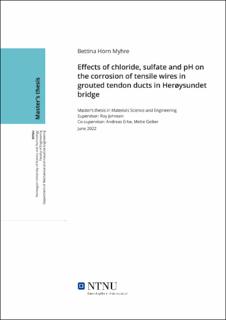| dc.description.abstract | The corrosion of steel reinforcement in concrete structures has proven to create problems for a long time, which is why much research have been devoted to discovering the cause. Numerous studies have focused on determining the effect of factors such as pH-levels, aggressive ion concentrations, carbonation, grout conditions and surface conditions. A selection of these studies has been presented in this thesis. The thesis also includes summaries of inspections and preliminary reports performed on Herøysundet bridge, which were used to provide the basis for experimental testing. Further, this study investigates how chloride and sulfate ions, pH levels and the presence of oxygen effect the corrosion of tensile wires immersed in a saturated Ca(OH)2 solu tion. Steel samples extracted from Farriseidet bridge were prepared for testing by being grinded, coated to create a specified exposure area and immersed in a concrete pore solu tion for seven days. The oxide layer built on the surface was found through inspections with scanning electron microscopy (SEM) to consist of CaCO3, which consist with the inspections of oxide layer made on samples extracted from Farriseidet bridge through similar test methods. Corrosion testing were conducted in saturated Ca(OH)2 solutions with varying concentrations of aggressive ions, pH levels and oxygen content, follow ing values measured in inspections of Herøysundet bridge and results from preliminary reports and from the specialization project. Cyclic polarization (CP) curves measured according to ASTM G61 standards revealed a chloride threshold level of 0.0025 M for solutions with a pH of 12.5. The removal of oxygen lead to a decrease in the corrosivity, while the addition of magnesium sulfate made the solution more aggressive. From the CP curves it also became clear that the source of sulfates affects the corrosivity of the solution. Open circuit potential (OCP) and linear polarization resistance (LPR) were measured during long-term exposure, followed by potentiodynamic polarization scans in order to see effects of real exposure conditions. Results suggested chloride threshold values above 0.01 M and gave indications of reduced corrosivity following the removal of oxygen. All tests indicate that ion contents and pH-levels measured in Herøysundet bridge are consistent with levels that cause corrosion attacks on the tensile wires | en_US |

